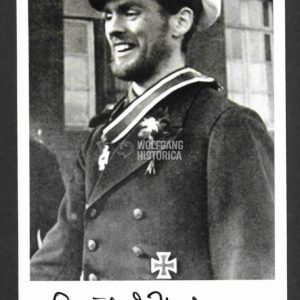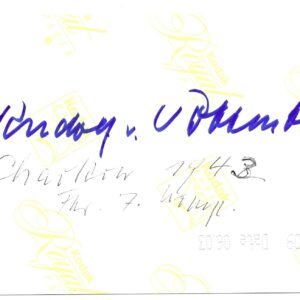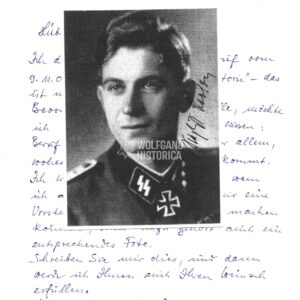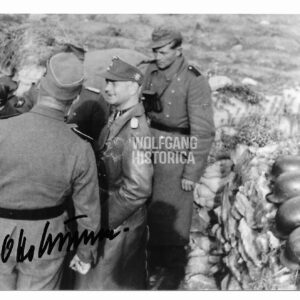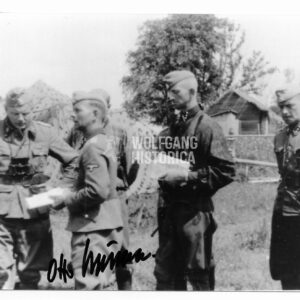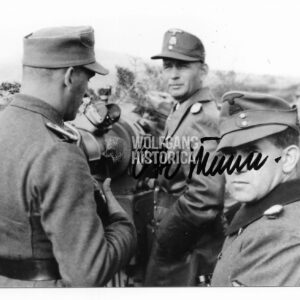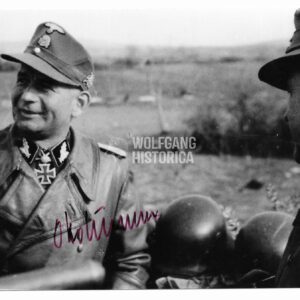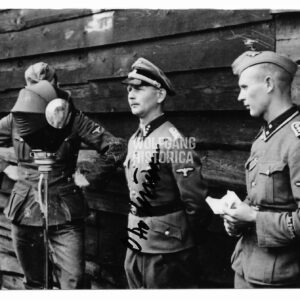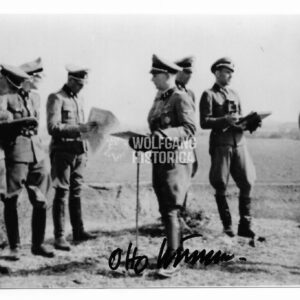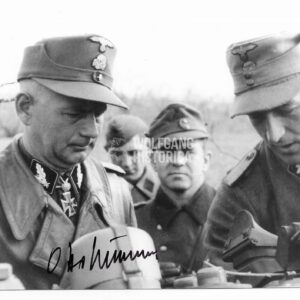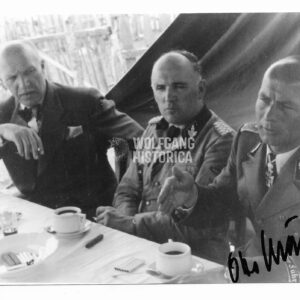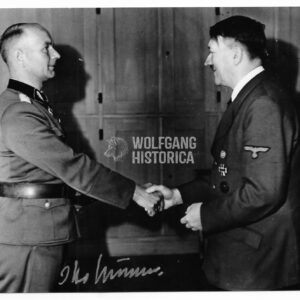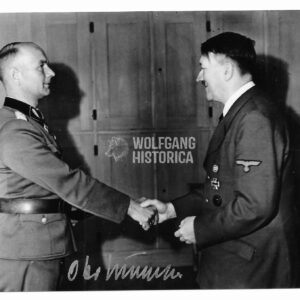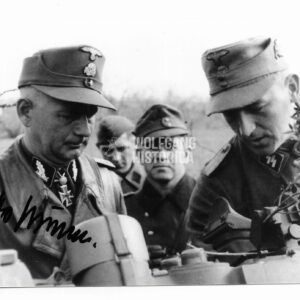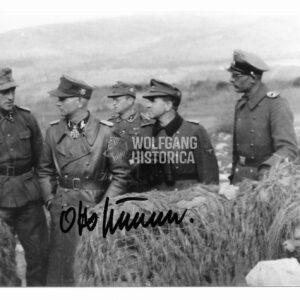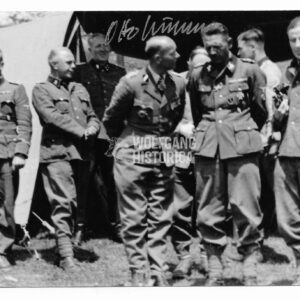Sign in
Login
Register
Reinhard Hardegen – Kommandant of “U-123” (Eichenlaub)
€55,00
Original Postwar Signature on a Postwar Photo of Reinhard Hardegen. Korvettenkäpitan Reinhard Hardegen (18.03.1913 † 09.06.2018) earned the Ritterkreuz des Eisernen Kreuzes on January 23, 1942 as Kapitänleutnant und Kommandant of U-123 and the Eichenlaub on April 23, 1942 as Kapitänleutnant und Kommandant of U-123. Postcardsize.
Add to Cart
Add to Compare
Creditted with sinking 25 ships (Read more on Reinhard Hardegen (Wikipedia))
Klaus Feldt – Schnellboot “S-30” & 2. Schnellbootflottille (Eichenlaub)
€35,00
Original Postwar Signature on a Postwar Photo of Klaus Feldt. Korvettenkapitän Klaus Feldt (14.04.1912 † 07.09.2010) earned the Ritterkreuz des Eisernen Kreuzes on June 13, 1942 as Oberleutnant zur See und Kommandant of Schnellboot “S-30” and the Eichenlaub on January 1, 1944 as Korvettenkapitän und Chef of the 2. Schnellbootflottille. Postcardsize.
Add to Cart
Add to Compare
Klaus Feldt – Schnellboot “S-30” & 2. Schnellbootflottille (Eichenlaub)
€35,00
Original Postwar Signature on a Postwar Photo of Klaus Feldt. Korvettenkapitän Klaus Feldt (14.04.1912 † 07.09.2010) earned the Ritterkreuz des Eisernen Kreuzes on June 13, 1942 as Oberleutnant zur See und Kommandant of Schnellboot “S-30” and the Eichenlaub on January 1, 1944 as Korvettenkapitän und Chef of the 2. Schnellbootflottille. Postcardsize.
Add to Cart
Add to Compare
Fritz Langanke – SS-Panzer-Regiment 2 “Das Reich” (Normandy)
€55,00
Original Postwar Signature on a Postwar Photo of Fritz Langanke. SS-Obersturmführer Fritz Langanke (15.07.1919 † 10.07.2012) earned the Ritterkreuz des Eisernen Kreuzes on August 27, 1944 as SS-Standarten-Oberjunker und Zugführer of the 2. Kompanie/ SS-Panzer-Regiment 2 of the 2. SS-Panzer-Division “Das Reich“. Postcardsize. Condition as seen.
Knight’s Cross: “SS-Standartenoberjunker Langanke, Zugführer in the II./SS-Pz.Rgt. 2, was separated from his Abteilung along with 3 Panthers on the 28.07.1944. In this time he made the independent decision to rally 300 Heer Grenadiers and launch a breakout attempt on the night of the 29./30.07.1944. Advancing via St. Denis he personally destroyed 13 tanks, 4 anti-tank guns, 8 halftracks and 10 trucks over a series of hard yet successful engagements. Ultimately he managed to make it back to friendly lines while also clearing open the way to freedom for many other units including a self-propelled Flak-Batterie (with five 3.7 cm guns), 2 Grille SPGs, 3 Sturmgeschützen and 29 trucks.”
Add to Cart
Add to Compare
Günter Wanhöfer – SS-Pionier-Bataillon 54 “Nederland”
€45,00
Original Postwar Signature on a Postwar Photo of Günter Wanhöfer. SS-Sturmbannführer Günter Wanhöfer (18.11.1916 † 07.08.2015) earned the Ritterkreuz on August 27, 1944 as SS-Hauptsturmführer und Kommandeur of the SS-Pionier-Bataillon 54 of the 23. SS-Freiwilligen-Panzer-Grenadier-Division “Nederland”. Postcardsize. Condition as seen.
Add to Cart
Add to Compare
Eberhard Heder – SS-Panzer-Pionier-Bataillon 5 “Wiking”
€50,00
Original Postwar Signature on a Postwar Photo of Eberhard Heder. SS-Sturmbannführer Eberhard Heder (30.06.1918 † 18.11.2017) earned the Deutsches Kreuz in Gold on March 11, 1943 as SS-Obersturmführer with the 3. Kompanie/ SS-Pionier-Bataillon 5 “Wiking” and the Ritterkreuz on November 18, 1944 as SS-Hauptsturmführer und Führer of the SS-Panzer-Pionier-Bataillon 5 of the 5. SS-Panzer-Division “Wiking”. Postcardsize. Condition as seen.
Add to Cart
Add to Compare
Eberhard Heder – SS-Panzer-Pionier-Bataillon 5 “Wiking”
€50,00
Original Postwar Signature on a Postwar Photo of Eberhard Heder. SS-Sturmbannführer Eberhard Heder (30.06.1918 † 18.11.2017) earned the Deutsches Kreuz in Gold on March 11, 1943 as SS-Obersturmführer with the 3. Kompanie/ SS-Pionier-Bataillon 5 “Wiking” and the Ritterkreuz on November 18, 1944 as SS-Hauptsturmführer und Führer of the SS-Panzer-Pionier-Bataillon 5 of the 5. SS-Panzer-Division “Wiking”. Postcardsize. Condition as seen.
Add to Cart
Add to Compare
Karl Brommann – schwere SS-Panzer-Abteilung 503 (King Tiger & Battle of Berlin!)
€55,00
Original Postwar Signature on a Postwar Photo of Karl Brommann. SS-Untersturmführer Karl Brommann (20.07.1920 in Neumünster † 30.06.2011 in Dithmarschen) earned the Ritterkreuz des Eisernen Kreuzes on April 29, 1945 as SS-Untersturmführer and Führer of the 1. Kompanie/ schwere SS-Panzer-Abteilung 503. Good condition. Postcardsize.
"On 14 November 1944 the unit was redesignated 503rd Heavy SS Panzer Battalion. It had a total of 39 (instead of the full complement of 45) Tiger IIs and was loaded onto trains on 27 January 1945, and sent to the Eastern Front in the Army Group Vistula sector. By 15 April 1945, the 503rd reported a total of 12 Tiger IIs, of which 10 were still operational. The 503rd ended the war fighting in the Battle of Berlin as part of Kampfgruppe Mohnke."
Add to Cart
Add to Compare
Karl Brommann – schwere SS-Panzer-Abteilung 503 (King Tiger & Battle of Berlin!)
€55,00
Original Postwar Signature on a Postwar Photo of Karl Brommann. SS-Untersturmführer Karl Brommann (20.07.1920 in Neumünster † 30.06.2011 in Dithmarschen) earned the Ritterkreuz des Eisernen Kreuzes on April 29, 1945 as SS-Untersturmführer and Führer of the 1. Kompanie/ schwere SS-Panzer-Abteilung 503. Good condition. Postcardsize.
"On 14 November 1944 the unit was redesignated 503rd Heavy SS Panzer Battalion. It had a total of 39 (instead of the full complement of 45) Tiger IIs and was loaded onto trains on 27 January 1945, and sent to the Eastern Front in the Army Group Vistula sector. By 15 April 1945, the 503rd reported a total of 12 Tiger IIs, of which 10 were still operational. The 503rd ended the war fighting in the Battle of Berlin as part of Kampfgruppe Mohnke."
Add to Cart
Add to Compare
Karl Brommann – schwere SS-Panzer-Abteilung 503 (King Tiger & Battle of Berlin!)
€55,00
Original Postwar Signature on a Postwar Photo of Karl Brommann. SS-Untersturmführer Karl Brommann (20.07.1920 in Neumünster † 30.06.2011 in Dithmarschen) earned the Ritterkreuz des Eisernen Kreuzes on April 29, 1945 as SS-Untersturmführer and Führer of the 1. Kompanie/ schwere SS-Panzer-Abteilung 503. Good condition. Postcardsize.
"On 14 November 1944 the unit was redesignated 503rd Heavy SS Panzer Battalion. It had a total of 39 (instead of the full complement of 45) Tiger IIs and was loaded onto trains on 27 January 1945, and sent to the Eastern Front in the Army Group Vistula sector. By 15 April 1945, the 503rd reported a total of 12 Tiger IIs, of which 10 were still operational. The 503rd ended the war fighting in the Battle of Berlin as part of Kampfgruppe Mohnke."
Add to Cart
Add to Compare
Soren Kam – SS-Panzer-Grenadier-Regiment 9 “Germania”
€45,00
Original Postwar Signature on a Postwar Photo of Søren Kam. SS-Obersturmführer Søren Kam (02.11.1921 † 23.03.2015) earned the Ritterkreuz des Eisernen Kreuzes on February 7, 1945 as SS-Untersturmführer und Führer of the 1. Kompanie/ SS-Panzer-Grenadier-Regiment 9 “Germania” of the 5. SS-Panzer-Division “Wiking”. Good condition. Postcardsize.
Add to Cart
Add to Compare
Soren Kam – SS-Panzer-Grenadier-Regiment 9 “Germania”
€45,00
Original Postwar Signature on a Postwar Photo of Søren Kam. SS-Obersturmführer Søren Kam (02.11.1921 † 23.03.2015) earned the Ritterkreuz des Eisernen Kreuzes on February 7, 1945 as SS-Untersturmführer und Führer of the 1. Kompanie/ SS-Panzer-Grenadier-Regiment 9 “Germania” of the 5. SS-Panzer-Division “Wiking”. Good condition. Postcardsize.
Add to Cart
Add to Compare
Herbert Reinecker – Waffen-SS & Creator of TV-Series “Derrick”
€35,00
Original Postwar Signature on a Postwar Photo of Herbert Reinecker. Herbert Reinecker (24.12.1914 in Hagen † 27.01.2007) worked as the editor-in-chief of a book entitled Der Pimpf about the training system of the Hitler Youth. Reinecker served in a propaganda company of the Waffen-SS during World War II. In the early 1940s, Reinecker also wrote a number of plays, among them Das Dorf bei Odessa, and the novel Der Mann mit der Geige. In 1944, he wrote an award-winning screenplay, Junge Adler (Young Eagles).
After the war, he started working for radio and television. At the same time, he wrote screenplays for the series of German feature films of the 1960s that were loosely based on Edgar Wallace's novels as well as TV adaptations of Francis Durbridge novels and plays.
In the late 1960s, Reinecker and producer Helmut Ringelmann wanted to create a truly German police detective. At first tentatively conceived as a "German Maigret", Reinecker's Kommissar Keller soon metamorphosed into a full-fledged character. Erik Ode was chosen to play Keller in the TV series, Der Kommissar, which was finally launched in 1969 and which became a huge success. In 1974, Reinecker and Ringelmann started a new, similar series, Derrick which was in production until 1998 with major international success.
Add to Cart
Add to Compare
Rudolf Werner – 1. SS-Panzer-Division “LSSAH” & Wach-Bataillon “LSSAH”
€30,00
Original Postwar Signature on a Postwar Photo of Rudolf Werner. SS-Sturmmann Rudolf Werner (17.07.1922-) served with the SS-Wach-Bataillon 1 & 1. SS-Panzer-Division “LSSAH” as Feldkoch than fought in the Kessel von Halbe. Good condition. Postcardsize.
Rudolf von Ribbentrop – SS-Panzer-Regiment 1 “LSSAH” & 12 “Hitlerjugend” (Kharkov, Kursk, Normandy & Ardennes!)
€55,00
Original Postwar Signature on a Postwar Photo of Rudolf von Ribbentrop. SS-Hauptsturmführer Rudolf von Ribbentrop (11.05.1921 in Wiesbaden † 20.05.2019 in Ratingen) earned the Ritterkreuz des Eisernen Kreuzes on July 15, 1943 as SS-Obersturmführer und Führer of the 6. Kompanie/ SS-Panzer-Regiment 1 of the 1. SS-Panzer-Division “LSSAH” and the Deutsches Kreuz in Gold on August 25, 1944 with the 3. Kompanie/ SS-Panzer-Regiment 12 of the 12. SS-Panzer-Division “Hitlerjugend”. Condition as seen.
He participated in many of the most famous battles of World War II: Kharkov, Kursk, Normandy, Falaise and the Ardennes!
Add to Cart
Add to Compare
Rudolf von Ribbentrop – SS-Panzer-Regiment 1 “LSSAH” & 12 “Hitlerjugend” (Kharkov, Kursk, Normandy & Ardennes!)
€55,00
Original Postwar Signature on a Postwar Photo of Rudolf von Ribbentrop. SS-Hauptsturmführer Rudolf von Ribbentrop (11.05.1921 in Wiesbaden † 20.05.2019 in Ratingen) earned the Ritterkreuz des Eisernen Kreuzes on July 15, 1943 as SS-Obersturmführer und Führer of the 6. Kompanie/ SS-Panzer-Regiment 1 of the 1. SS-Panzer-Division “LSSAH” and the Deutsches Kreuz in Gold on August 25, 1944 with the 3. Kompanie/ SS-Panzer-Regiment 12 of the 12. SS-Panzer-Division “Hitlerjugend”. Condition as seen.
He participated in many of the most famous battles of World War II: Kharkov, Kursk, Normandy, Falaise and the Ardennes!
Add to Cart
Add to Compare
Harald Nugiseks – 20. Waffen-Grenadier-Division der SS (estnische Nr. 1)
€35,00
Original Postwar Signature on a Postwar Photo of Harald Nugiseks. Waffen-Oberscharführer Harald Nugiseks (22.10.1921 † 02.01.2014) earned the Ritterkreuz des Eisernen Kreuzes on April 9, 1944 as Waffen-Unterscharführer und Zugführer in the 1. Kompanie/ SS-Freiwilligen-Grenadier-Regiment 46 of the 20. Waffen-Grenadier-Division der SS (estnische Nr. 1).
Add to Cart
Add to Compare
Harald Nugiseks – 20. Waffen-Grenadier-Division der SS (estnische Nr. 1)
€35,00
Original Postwar Signature on a Postwar Photo of Harald Nugiseks. Waffen-Oberscharführer Harald Nugiseks (22.10.1921 † 02.01.2014) earned the Ritterkreuz des Eisernen Kreuzes on April 9, 1944 as Waffen-Unterscharführer und Zugführer in the 1. Kompanie/ SS-Freiwilligen-Grenadier-Regiment 46 of the 20. Waffen-Grenadier-Division der SS (estnische Nr. 1).
Add to Cart
Add to Compare
Rudolf von Ribbentrop – SS-Panzer-Regiment 1 “LSSAH” & 12 “Hitlerjugend” (Kharkov, Kursk, Normandy & Ardennes!)
€55,00
Original Postwar Signature on a Postwar Photo of Rudolf von Ribbentrop. SS-Hauptsturmführer Rudolf von Ribbentrop (11.05.1921 in Wiesbaden † 20.05.2019 in Ratingen) earned the Ritterkreuz des Eisernen Kreuzes on July 15, 1943 as SS-Obersturmführer und Führer of the 6. Kompanie/ SS-Panzer-Regiment 1 of the 1. SS-Panzer-Division “LSSAH” and the Deutsches Kreuz in Gold on August 25, 1944 with the 3. Kompanie/ SS-Panzer-Regiment 12 of the 12. SS-Panzer-Division “Hitlerjugend”. Condition as seen.
He participated in many of the most famous battles of World War II: Kharkov, Kursk, Normandy, Falaise and the Ardennes!
Add to Cart
Add to Compare
Harald Nugiseks – 20. Waffen-Grenadier-Division der SS (estnische Nr. 1)
€45,00
Original Postwar Signature on a Postwar Photo & Letter of Harald Nugiseks. Waffen-Oberscharführer Harald Nugiseks (22.10.1921 † 02.01.2014) earned the Ritterkreuz des Eisernen Kreuzes on April 9, 1944 as Waffen-Unterscharführer und Zugführer in the 1. Kompanie/ SS-Freiwilligen-Grenadier-Regiment 46 of the 20. Waffen-Grenadier-Division der SS (estnische Nr. 1).
Add to Cart
Add to Compare
Siegfried Brosow – SS-Pionier-Bataillon 2 “Das Reich”
€60,00
Original Postwar Signature on a Postwar Photo & Letter of Siegfried Brosow. SS-Hauptsturmführer Siegfried Brosow (10.12.1918 † 18.11.2008) earned the Ritterkreuz des Eisernen Kreuzes on November 13, 1943 as SS-Hauptsturmführer und Chef of the 1. Kompanie/ SS-Pionier-Bataillon 2 of the 2. SS-Panzer-Division “Das Reich”. Good Condition.
Add to Cart
Add to Compare
Johann Sailer – SS-Panzerjäger-Abteilung 9 “Hohenstaufen”
€40,00
Original Postwar Signature on a Postwar Photo of Johann Sailer. SS-Obersturmführer Johann Sailer (23.12.1991 † 12.11.2005) earned (cancelled) the Ritterkreuz des Eisernen Kreuzes on May 4, 1945 as SS-Obersturmführer und Führer of the 3. Kompanie/ SS-Panzerjäger-Abteilung 9 of the 9. SS-Panzer-Division “Hohenstaufen”.
Add to Cart
Add to Compare
Karl Nicolussi-Leck – SS-Panzer-Regiment 5 “Wiking”
€55,00
Original Postwar Signature on a Postwar Photo of Karl Nicolussi-Leck. SS-Hauptsturmführer Karl Nicolussi-Leck earned the Ritterkreuz on April 9, 1944 as SS-Obersturmführer und Chef of the 8. Kompanie/ SS-Panzer-Regiment 5 of the 5. SS-Panzer-Division “Wiking”.
Karl Nicolussi-Leck was the commander of a Panther company in the 5. SS-Panzer-Division “Wiking” during its efforts to relieve the trapped garrison at Kovel in March 1944. On the 27th of that month, with the German relief efforts still in progress, Nicolussi-Leck received an order to halt all offensive actions. By this point he was in radio conduct with the garrison, and felt that its relief was of the utmost importance. He thus told his radio operator to send a reply stating that he (Nicolussi-Leck) could not be found, and with that continued the push to the town. Three days later, following difficult fighting, he was able to reach the trapped garrison with seven tanks on the early morning of the 30th. By doing so he was able to substantially reinforce the garrison’s defences, and he remained with them until Kovel was finally relieved for good. His recommendation also says that he destroyed 17 tanks in the process, although it is possible this number is for the whole company. Either way, Nicolussi-Leck’s actions were judged to be worthy of the Knight’s Cross, and he received this award shortly afterwards. (Source: Traces of War)
Add to Cart
Add to Compare
Harald Nugiseks – 20. Waffen-Grenadier-Division der SS (estnische Nr. 1)
€35,00
Original Postwar Signature on a Postwar Photo of Harald Nugiseks. Waffen-Oberscharführer Harald Nugiseks (22.10.1921 † 02.01.2014) earned the Ritterkreuz des Eisernen Kreuzes on April 9, 1944 as Waffen-Unterscharführer und Zugführer in the 1. Kompanie/ SS-Freiwilligen-Grenadier-Regiment 46 of the 20. Waffen-Grenadier-Division der SS (estnische Nr. 1).
Add to Cart
Add to Compare
Rudolf von Ribbentrop – SS-Panzer-Regiment 1 “LSSAH” & 12 “Hitlerjugend”
€55,00
Original Postwar Signature on a Postwar Photo of Rudolf von Ribbentrop. SS-Hauptsturmführer Rudolf von Ribbentrop (11.05.1921 in Wiesbaden † 20.05.2019 in Ratingen) earned the Ritterkreuz des Eisernen Kreuzes on July 15, 1943 as SS-Obersturmführer und Führer of the 6. Kompanie/ SS-Panzer-Regiment 1 of the 1. SS-Panzer-Division “LSSAH” and the Deutsches Kreuz in Gold on August 25, 1944 with the 3. Kompanie/ SS-Panzer-Regiment 12 of the 12. SS-Panzer-Division “Hitlerjugend”. Postcardsize. Condition as seen.
Add to Cart
Add to Compare
Rudolf von Ribbentrop – SS-Panzer-Regiment 1 “LSSAH” & 12 “Hitlerjugend”
€55,00
Original Postwar Signature on a Postwar Photo of Rudolf von Ribbentrop. SS-Hauptsturmführer Rudolf von Ribbentrop (11.05.1921 in Wiesbaden † 20.05.2019 in Ratingen) earned the Ritterkreuz des Eisernen Kreuzes on July 15, 1943 as SS-Obersturmführer und Führer of the 6. Kompanie/ SS-Panzer-Regiment 1 of the 1. SS-Panzer-Division “LSSAH” and the Deutsches Kreuz in Gold on August 25, 1944 with the 3. Kompanie/ SS-Panzer-Regiment 12 of the 12. SS-Panzer-Division “Hitlerjugend”. Postcardsize. Condition as seen.
Add to Cart
Add to Compare
Rudolf von Ribbentrop – SS-Panzer-Regiment 1 “LSSAH” & 12 “Hitlerjugend”
€55,00
Original Postwar Signature on a Postwar Photo of Rudolf von Ribbentrop. SS-Hauptsturmführer Rudolf von Ribbentrop (11.05.1921 in Wiesbaden † 20.05.2019 in Ratingen) earned the Ritterkreuz des Eisernen Kreuzes on July 15, 1943 as SS-Obersturmführer und Führer of the 6. Kompanie/ SS-Panzer-Regiment 1 of the 1. SS-Panzer-Division “LSSAH” and the Deutsches Kreuz in Gold on August 25, 1944 with the 3. Kompanie/ SS-Panzer-Regiment 12 of the 12. SS-Panzer-Division “Hitlerjugend”. Postcardsize. Condition as seen.
Add to Cart
Add to Compare
Otto Kumm – Regiment “Der Führer” & Division “Prinz Eugen” (Schwertern)
€70,00
Original Postwar Signature on a Postwar Photo of Otto Kumm. SS-Brigadeführer Otto Kumm (01.10.1909 † 23.03.2004) earned the Ritterkreuz on February 16, 1942 as SS-Obersturmbannführer und Kommandeur of the SS-Infanterie-Regiment “Der Führer”, the Eichenlaub on April 6, 1943 as SS-Obersturmbannführer und Kommandeur of the SS-Panzer-Grenadier-Regiment 4 “Der Führer” of the 2. SS-Panzer-Division “Das Reich“ and the Schwertern on March 17, 1945 as SS-Brigadeführer und Kommandeur of 7. SS-Freiwilligen-Gebirgs-Division “Prinz Eugen”.
Read more on Otto Kumm (Wikipedia)
Provenance: This signature comes from one of the largest postwar signature collection I’ve ever commissioned. This collection was started by a Waffen-SS Veteran, Werner H., in the 1950’s until he passed away.
Add to Cart
Add to Compare
Otto Kumm – Regiment “Der Führer” & Division “Prinz Eugen” (Schwertern)
€70,00
Original Postwar Signature on a Postwar Photo of Otto Kumm. SS-Brigadeführer Otto Kumm (01.10.1909 † 23.03.2004) earned the Ritterkreuz on February 16, 1942 as SS-Obersturmbannführer und Kommandeur of the SS-Infanterie-Regiment “Der Führer”, the Eichenlaub on April 6, 1943 as SS-Obersturmbannführer und Kommandeur of the SS-Panzer-Grenadier-Regiment 4 “Der Führer” of the 2. SS-Panzer-Division “Das Reich“ and the Schwertern on March 17, 1945 as SS-Brigadeführer und Kommandeur of 7. SS-Freiwilligen-Gebirgs-Division “Prinz Eugen”.
Read more on Otto Kumm (Wikipedia)
Provenance: This signature comes from one of the largest postwar signature collection I’ve ever commissioned. This collection was started by a Waffen-SS Veteran, Werner H., in the 1950’s until he passed away.
Add to Cart
Add to Compare
Otto Kumm – Regiment “Der Führer” & Division “Prinz Eugen” (Schwertern)
€70,00
Original Postwar Signature on a Postwar Photo of Otto Kumm. SS-Brigadeführer Otto Kumm (01.10.1909 † 23.03.2004) earned the Ritterkreuz on February 16, 1942 as SS-Obersturmbannführer und Kommandeur of the SS-Infanterie-Regiment “Der Führer”, the Eichenlaub on April 6, 1943 as SS-Obersturmbannführer und Kommandeur of the SS-Panzer-Grenadier-Regiment 4 “Der Führer” of the 2. SS-Panzer-Division “Das Reich“ and the Schwertern on March 17, 1945 as SS-Brigadeführer und Kommandeur of 7. SS-Freiwilligen-Gebirgs-Division “Prinz Eugen”.
Read more on Otto Kumm (Wikipedia)
Provenance: This signature comes from one of the largest postwar signature collection I’ve ever commissioned. This collection was started by a Waffen-SS Veteran, Werner H., in the 1950’s until he passed away.
Add to Cart
Add to Compare
Otto Kumm – Regiment “Der Führer” & Division “Prinz Eugen” (Schwertern)
€70,00
Original Postwar Signature on a Postwar Photo of Otto Kumm. SS-Brigadeführer Otto Kumm (01.10.1909 † 23.03.2004) earned the Ritterkreuz on February 16, 1942 as SS-Obersturmbannführer und Kommandeur of the SS-Infanterie-Regiment “Der Führer”, the Eichenlaub on April 6, 1943 as SS-Obersturmbannführer und Kommandeur of the SS-Panzer-Grenadier-Regiment 4 “Der Führer” of the 2. SS-Panzer-Division “Das Reich“ and the Schwertern on March 17, 1945 as SS-Brigadeführer und Kommandeur of 7. SS-Freiwilligen-Gebirgs-Division “Prinz Eugen”.
Read more on Otto Kumm (Wikipedia)
Provenance: This signature comes from one of the largest postwar signature collection I’ve ever commissioned. This collection was started by a Waffen-SS Veteran, Werner H., in the 1950’s until he passed away.
Add to Cart
Add to Compare
Otto Kumm – Regiment “Der Führer” & Division “Prinz Eugen” (Schwertern)
€70,00
Original Postwar Signature on a Postwar Photo of Otto Kumm. SS-Brigadeführer Otto Kumm (01.10.1909 † 23.03.2004) earned the Ritterkreuz on February 16, 1942 as SS-Obersturmbannführer und Kommandeur of the SS-Infanterie-Regiment “Der Führer”, the Eichenlaub on April 6, 1943 as SS-Obersturmbannführer und Kommandeur of the SS-Panzer-Grenadier-Regiment 4 “Der Führer” of the 2. SS-Panzer-Division “Das Reich“ and the Schwertern on March 17, 1945 as SS-Brigadeführer und Kommandeur of 7. SS-Freiwilligen-Gebirgs-Division “Prinz Eugen”.
Read more on Otto Kumm (Wikipedia)
Provenance: This signature comes from one of the largest postwar signature collection I’ve ever commissioned. This collection was started by a Waffen-SS Veteran, Werner H., in the 1950’s until he passed away.
Add to Cart
Add to Compare
Otto Kumm – Regiment “Der Führer” & Division “Prinz Eugen” (Schwertern)
€70,00
Original Postwar Signature on a Postwar Photo of Otto Kumm. SS-Brigadeführer Otto Kumm (01.10.1909 † 23.03.2004) earned the Ritterkreuz on February 16, 1942 as SS-Obersturmbannführer und Kommandeur of the SS-Infanterie-Regiment “Der Führer”, the Eichenlaub on April 6, 1943 as SS-Obersturmbannführer und Kommandeur of the SS-Panzer-Grenadier-Regiment 4 “Der Führer” of the 2. SS-Panzer-Division “Das Reich“ and the Schwertern on March 17, 1945 as SS-Brigadeführer und Kommandeur of 7. SS-Freiwilligen-Gebirgs-Division “Prinz Eugen”.
Read more on Otto Kumm (Wikipedia)
Provenance: This signature comes from one of the largest postwar signature collection I’ve ever commissioned. This collection was started by a Waffen-SS Veteran, Werner H., in the 1950’s until he passed away.
Add to Cart
Add to Compare
Otto Kumm – Regiment “Der Führer” & Division “Prinz Eugen” (Schwertern)
€70,00
Original Postwar Signature on a Postwar Photo of Otto Kumm. SS-Brigadeführer Otto Kumm (01.10.1909 † 23.03.2004) earned the Ritterkreuz on February 16, 1942 as SS-Obersturmbannführer und Kommandeur of the SS-Infanterie-Regiment “Der Führer”, the Eichenlaub on April 6, 1943 as SS-Obersturmbannführer und Kommandeur of the SS-Panzer-Grenadier-Regiment 4 “Der Führer” of the 2. SS-Panzer-Division “Das Reich“ and the Schwertern on March 17, 1945 as SS-Brigadeführer und Kommandeur of 7. SS-Freiwilligen-Gebirgs-Division “Prinz Eugen”.
Read more on Otto Kumm (Wikipedia)
Provenance: This signature comes from one of the largest postwar signature collection I’ve ever commissioned. This collection was started by a Waffen-SS Veteran, Werner H., in the 1950’s until he passed away.
Add to Cart
Add to Compare
Otto Kumm – Regiment “Der Führer” & Division “Prinz Eugen” (Schwertern)
€70,00
Original Postwar Signature on a Postwar Photo of Otto Kumm. SS-Brigadeführer Otto Kumm (01.10.1909 † 23.03.2004) earned the Ritterkreuz on February 16, 1942 as SS-Obersturmbannführer und Kommandeur of the SS-Infanterie-Regiment “Der Führer”, the Eichenlaub on April 6, 1943 as SS-Obersturmbannführer und Kommandeur of the SS-Panzer-Grenadier-Regiment 4 “Der Führer” of the 2. SS-Panzer-Division “Das Reich“ and the Schwertern on March 17, 1945 as SS-Brigadeführer und Kommandeur of 7. SS-Freiwilligen-Gebirgs-Division “Prinz Eugen”.
Read more on Otto Kumm (Wikipedia)
Provenance: This signature comes from one of the largest postwar signature collection I’ve ever commissioned. This collection was started by a Waffen-SS Veteran, Werner H., in the 1950’s until he passed away.
Add to Cart
Add to Compare
Otto Kumm – Regiment “Der Führer” & Division “Prinz Eugen” (Schwertern)
€70,00
Original Postwar Signature on a Postwar Photo of Otto Kumm. SS-Brigadeführer Otto Kumm (01.10.1909 † 23.03.2004) earned the Ritterkreuz on February 16, 1942 as SS-Obersturmbannführer und Kommandeur of the SS-Infanterie-Regiment “Der Führer”, the Eichenlaub on April 6, 1943 as SS-Obersturmbannführer und Kommandeur of the SS-Panzer-Grenadier-Regiment 4 “Der Führer” of the 2. SS-Panzer-Division “Das Reich“ and the Schwertern on March 17, 1945 as SS-Brigadeführer und Kommandeur of 7. SS-Freiwilligen-Gebirgs-Division “Prinz Eugen”.
Read more on Otto Kumm (Wikipedia)
Provenance: This signature comes from one of the largest postwar signature collection I’ve ever commissioned. This collection was started by a Waffen-SS Veteran, Werner H., in the 1950’s until he passed away.
Add to Cart
Add to Compare
Otto Kumm – Regiment “Der Führer” & Division “Prinz Eugen” (Schwertern)
€70,00
Original Postwar Signature on a Postwar Photo of Otto Kumm. SS-Brigadeführer Otto Kumm (01.10.1909 † 23.03.2004) earned the Ritterkreuz on February 16, 1942 as SS-Obersturmbannführer und Kommandeur of the SS-Infanterie-Regiment “Der Führer”, the Eichenlaub on April 6, 1943 as SS-Obersturmbannführer und Kommandeur of the SS-Panzer-Grenadier-Regiment 4 “Der Führer” of the 2. SS-Panzer-Division “Das Reich“ and the Schwertern on March 17, 1945 as SS-Brigadeführer und Kommandeur of 7. SS-Freiwilligen-Gebirgs-Division “Prinz Eugen”.
Read more on Otto Kumm (Wikipedia)
Provenance: This signature comes from one of the largest postwar signature collection I’ve ever commissioned. This collection was started by a Waffen-SS Veteran, Werner H., in the 1950’s until he passed away.
Add to Cart
Add to Compare
Otto Kumm – Regiment “Der Führer” & Division “Prinz Eugen” (Schwertern)
€70,00
Original Postwar Signature on a Postwar Photo of Otto Kumm. SS-Brigadeführer Otto Kumm (01.10.1909 † 23.03.2004) earned the Ritterkreuz on February 16, 1942 as SS-Obersturmbannführer und Kommandeur of the SS-Infanterie-Regiment “Der Führer”, the Eichenlaub on April 6, 1943 as SS-Obersturmbannführer und Kommandeur of the SS-Panzer-Grenadier-Regiment 4 “Der Führer” of the 2. SS-Panzer-Division “Das Reich“ and the Schwertern on March 17, 1945 as SS-Brigadeführer und Kommandeur of 7. SS-Freiwilligen-Gebirgs-Division “Prinz Eugen”.
Read more on Otto Kumm (Wikipedia)
Provenance: This signature comes from one of the largest postwar signature collection I’ve ever commissioned. This collection was started by a Waffen-SS Veteran, Werner H., in the 1950’s until he passed away.
Add to Cart
Add to Compare
Sylvester Stadler – “Der Führer” & “Hohenstaufen” (Schwertern + NKIG)
€60,00
Original Postwar Signature on a Postwar Photo of Sylvester Stadler. SS-Oberführer Sylvester Stadler (24.04.1911 † 25.05.1995) earned the Ritterkreuz on April 6, 1943 as SS-Sturmbannführer und Kommandeur of the II. Bataillon/ SS-Panzer-Grenadier-Regiment 4 “Der Führer”, the Eichenlaub on September 16, 1943 as SS-Obersturmbannführer und Kommandeur of the SS-Panzer-Grenadier-Regiment 4 “Der Führer” of the 2. SS-Panzer-Division “Das Reich“, the Nahkampfspange in Gold on December 12, 1943 with the SS-Panzer-Grenadier-Regiment 4 “Der Führer” and the Schwertern on May 6, 1945 as SS-Oberführer und Kommandeur of 9. SS-Panzer-Division “Hohenstaufen”. Little bit bigger as PC-size.
Provenance: This signature comes from one of the largest postwar signature collection I’ve ever commissioned. This collection was started by a Waffen-SS Veteran, Werner H., in the 1950’s until he passed away.
Add to Cart
Add to Compare
Sylvester Stadler – “Der Führer” & “Hohenstaufen” (Schwertern + NKIG)
€60,00
Original Postwar Signature on a Postwar Photo of Sylvester Stadler. SS-Oberführer Sylvester Stadler (24.04.1911 † 25.05.1995) earned the Ritterkreuz on April 6, 1943 as SS-Sturmbannführer und Kommandeur of the II. Bataillon/ SS-Panzer-Grenadier-Regiment 4 “Der Führer”, the Eichenlaub on September 16, 1943 as SS-Obersturmbannführer und Kommandeur of the SS-Panzer-Grenadier-Regiment 4 “Der Führer” of the 2. SS-Panzer-Division “Das Reich“, the Nahkampfspange in Gold on December 12, 1943 with the SS-Panzer-Grenadier-Regiment 4 “Der Führer” and the Schwertern on May 6, 1945 as SS-Oberführer und Kommandeur of 9. SS-Panzer-Division “Hohenstaufen”.
Provenance: This signature comes from one of the largest postwar signature collection I’ve ever commissioned. This collection was started by a Waffen-SS Veteran, Werner H., in the 1950’s until he passed away.
Add to Cart
Add to Compare
Friedrich Kemnade – 3. Schnellbootsflottille (Eichenlaub)
€40,00
Original Postwar Signature on a Postwar Photo of Friedrich Kemnade. Korvettenkapitän Friedrich Kemnade (06.03.1915 † 25.03.1990) earned the Ritterkreuz des Eisernen Kreuzes on July 23, 1942 as Kapitänleutnant und Chef and the Eichenlaub on May 27, 1943 as Korvettenkapitän und Chef of of the 3. Schnellbootsflottille.
Provenance: This signature comes from one of the largest postwar signature collection I’ve ever commissioned. This collection was started by a Waffen-SS Veteran, Werner H., in the 1950’s until he passed away.
Add to Cart
Add to Compare
Otto Kumm – Regiment “Der Führer” & Division “Prinz Eugen” (Schwertern)
€70,00
Original Postwar Signature on a Postwar Photo of Otto Kumm. SS-Brigadeführer Otto Kumm (01.10.1909 † 23.03.2004) earned the Ritterkreuz on February 16, 1942 as SS-Obersturmbannführer und Kommandeur of the SS-Infanterie-Regiment “Der Führer”, the Eichenlaub on April 6, 1943 as SS-Obersturmbannführer und Kommandeur of the SS-Panzer-Grenadier-Regiment 4 “Der Führer” of the 2. SS-Panzer-Division “Das Reich“ and the Schwertern on March 17, 1945 as SS-Brigadeführer und Kommandeur of 7. SS-Freiwilligen-Gebirgs-Division “Prinz Eugen”.
Read more on Otto Kumm (Wikipedia)
Provenance: This signature comes from one of the largest postwar signature collection I’ve ever commissioned. This collection was started by a Waffen-SS Veteran, Werner H., in the 1950’s until he passed away.
Add to Cart
Add to Compare
Otto Kumm – Regiment “Der Führer” & Division “Prinz Eugen” (Schwertern)
€70,00
Original Postwar Signature on a Postwar Photo of Otto Kumm. SS-Brigadeführer Otto Kumm (01.10.1909 † 23.03.2004) earned the Ritterkreuz on February 16, 1942 as SS-Obersturmbannführer und Kommandeur of the SS-Infanterie-Regiment “Der Führer”, the Eichenlaub on April 6, 1943 as SS-Obersturmbannführer und Kommandeur of the SS-Panzer-Grenadier-Regiment 4 “Der Führer” of the 2. SS-Panzer-Division “Das Reich“ and the Schwertern on March 17, 1945 as SS-Brigadeführer und Kommandeur of 7. SS-Freiwilligen-Gebirgs-Division “Prinz Eugen”.
Read more on Otto Kumm (Wikipedia)
Provenance: This signature comes from one of the largest postwar signature collection I’ve ever commissioned. This collection was started by a Waffen-SS Veteran, Werner H., in the 1950’s until he passed away.
Add to Cart
Add to Compare
Otto Kumm – Regiment “Der Führer” & Division “Prinz Eugen” (Schwertern)
€70,00
Original Postwar Signature on a Postwar Photo of Otto Kumm. SS-Brigadeführer Otto Kumm (01.10.1909 † 23.03.2004) earned the Ritterkreuz on February 16, 1942 as SS-Obersturmbannführer und Kommandeur of the SS-Infanterie-Regiment “Der Führer”, the Eichenlaub on April 6, 1943 as SS-Obersturmbannführer und Kommandeur of the SS-Panzer-Grenadier-Regiment 4 “Der Führer” of the 2. SS-Panzer-Division “Das Reich“ and the Schwertern on March 17, 1945 as SS-Brigadeführer und Kommandeur of 7. SS-Freiwilligen-Gebirgs-Division “Prinz Eugen”.
Read more on Otto Kumm (Wikipedia)
Provenance: This signature comes from one of the largest postwar signature collection I’ve ever commissioned. This collection was started by a Waffen-SS Veteran, Werner H., in the 1950’s until he passed away.
Add to Cart
Add to Compare
Otto Kumm – Regiment “Der Führer” & Division “Prinz Eugen” (Schwertern)
€70,00
Original Postwar Signature on a Postwar Photo of Otto Kumm. SS-Brigadeführer Otto Kumm (01.10.1909 † 23.03.2004) earned the Ritterkreuz on February 16, 1942 as SS-Obersturmbannführer und Kommandeur of the SS-Infanterie-Regiment “Der Führer”, the Eichenlaub on April 6, 1943 as SS-Obersturmbannführer und Kommandeur of the SS-Panzer-Grenadier-Regiment 4 “Der Führer” of the 2. SS-Panzer-Division “Das Reich“ and the Schwertern on March 17, 1945 as SS-Brigadeführer und Kommandeur of 7. SS-Freiwilligen-Gebirgs-Division “Prinz Eugen”.
Read more on Otto Kumm (Wikipedia)
Provenance: This signature comes from one of the largest postwar signature collection I’ve ever commissioned. This collection was started by a Waffen-SS Veteran, Werner H., in the 1950’s until he passed away.
Add to Cart
Add to Compare
Otto Kumm – Regiment “Der Führer” & Division “Prinz Eugen” (Schwertern)
€70,00
Original Postwar Signature on a Postwar Photo of Otto Kumm. SS-Brigadeführer Otto Kumm (01.10.1909 † 23.03.2004) earned the Ritterkreuz on February 16, 1942 as SS-Obersturmbannführer und Kommandeur of the SS-Infanterie-Regiment “Der Führer”, the Eichenlaub on April 6, 1943 as SS-Obersturmbannführer und Kommandeur of the SS-Panzer-Grenadier-Regiment 4 “Der Führer” of the 2. SS-Panzer-Division “Das Reich“ and the Schwertern on March 17, 1945 as SS-Brigadeführer und Kommandeur of 7. SS-Freiwilligen-Gebirgs-Division “Prinz Eugen”.
Read more on Otto Kumm (Wikipedia)
Provenance: This signature comes from one of the largest postwar signature collection I’ve ever commissioned. This collection was started by a Waffen-SS Veteran, Werner H., in the 1950’s until he passed away.
Add to Cart
Add to Compare
Otto Kumm – Regiment “Der Führer” & Division “Prinz Eugen” (Schwertern)
€70,00
Original Postwar Signature on a Postwar Photo of Otto Kumm. SS-Brigadeführer Otto Kumm (01.10.1909 † 23.03.2004) earned the Ritterkreuz on February 16, 1942 as SS-Obersturmbannführer und Kommandeur of the SS-Infanterie-Regiment “Der Führer”, the Eichenlaub on April 6, 1943 as SS-Obersturmbannführer und Kommandeur of the SS-Panzer-Grenadier-Regiment 4 “Der Führer” of the 2. SS-Panzer-Division “Das Reich“ and the Schwertern on March 17, 1945 as SS-Brigadeführer und Kommandeur of 7. SS-Freiwilligen-Gebirgs-Division “Prinz Eugen”.
Read more on Otto Kumm (Wikipedia)
Provenance: This signature comes from one of the largest postwar signature collection I’ve ever commissioned. This collection was started by a Waffen-SS Veteran, Werner H., in the 1950’s until he passed away.
Add to Cart
Add to Compare
Otto Kumm – Regiment “Der Führer” & Division “Prinz Eugen” (Schwertern)
€70,00
Original Postwar Signature on a Postwar Photo of Otto Kumm. SS-Brigadeführer Otto Kumm (01.10.1909 † 23.03.2004) earned the Ritterkreuz on February 16, 1942 as SS-Obersturmbannführer und Kommandeur of the SS-Infanterie-Regiment “Der Führer”, the Eichenlaub on April 6, 1943 as SS-Obersturmbannführer und Kommandeur of the SS-Panzer-Grenadier-Regiment 4 “Der Führer” of the 2. SS-Panzer-Division “Das Reich“ and the Schwertern on March 17, 1945 as SS-Brigadeführer und Kommandeur of 7. SS-Freiwilligen-Gebirgs-Division “Prinz Eugen”.
Read more on Otto Kumm (Wikipedia)
Provenance: This signature comes from one of the largest postwar signature collection I’ve ever commissioned. This collection was started by a Waffen-SS Veteran, Werner H., in the 1950’s until he passed away.
Add to Cart
Add to Compare
Product Status
All Categories
Brands
Sorry, we couldn't find what you're looking for

